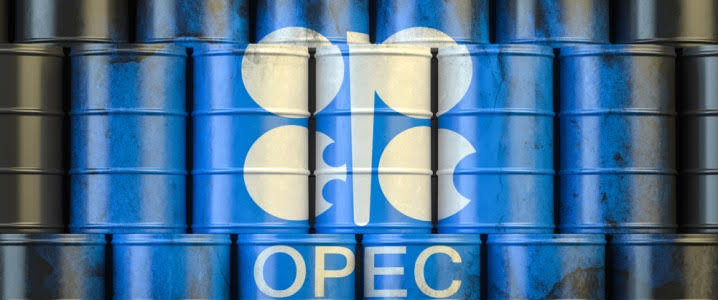Add your promotional text...
OPEC+ Extends Production Cuts Through December: UBS Analysts See Positive Impact on Oil Prices
Synopsis: In a move aligned with previous commitments, OPEC+ has extended its oil production cuts through December 2024. UBS analysts view this as a steadying influence on oil prices, especially as global demand shows signs of seasonal cooling. This blog unpacks the motivations and implications of OPEC+'s strategy, including the anticipated market effects, concerns over supply dynamics, and what lies ahead for oil prices in 2025.
COMMODITIES
By Ekta Mani
11/4/20243 min read


The Organization of the Petroleum Exporting Countries and its allies, collectively known as OPEC+, recently decided to extend their existing oil production cuts through December 2024. This extension, keeping 2.2 million barrels per day (Mb/d) off the market, was initially agreed upon last year, and UBS analysts see this decision as a stabilizing factor for oil prices. Here’s an in-depth look at the reasoning behind OPEC+’s strategy and what it could mean for energy markets in the near future.
Short-Term Price Stability
UBS analysts describe the extension as a “modest but positive” move for oil prices, signaling OPEC+’s commitment to supporting the oil market amid fluctuations. Prior to this announcement, speculation was rife about a potential production increase, which had created some market uncertainty. UBS suggests that by maintaining the current production cuts, OPEC+ is providing a more predictable supply framework, alleviating fears of oversupply and helping to keep prices relatively stable in the short term.
Seasonal Demand and Supply Dynamics
Historically, oil demand tends to taper off as the year-end approaches, driven by seasonal shifts and lower energy usage in the winter months. UBS highlights that OPEC+ is mindful of these seasonal trends and has chosen a cautious path. With demand expected to be softer, OPEC+’s choice to hold back on increasing production aligns well with the market’s needs at this time.
In addition to seasonal demand fluctuations, recent production increases from Libya have helped ease supply constraints. Given Libya’s additional barrels in the global supply chain, the extended cuts from OPEC+ are a strategic counterbalance to maintain stability in oil prices and avoid any sudden dips that could disrupt the market.
Compliance Challenges within OPEC+ Members
One of the complexities in managing OPEC+ production cuts is ensuring compliance among member countries. UBS notes that several member states—namely Iraq, Kazakhstan, and Russia—have exceeded their previous production targets, raising concerns about adherence to the agreed terms. The continuity of these cuts signals a prudent stance by OPEC+ leaders, underscoring their commitment to balancing market needs with the practicalities of member compliance.
By maintaining the cuts, OPEC+ also mitigates risks associated with non-compliant production surges, which can disrupt global oil supply and impact pricing. This adherence not only reflects the cooperative nature of OPEC+ but also highlights the collective resolve to manage global oil prices, even amidst mixed compliance.
Looking Ahead: Production Policy and Market Conditions in 2025
The current extension will carry through to December, when OPEC+ is expected to reassess its production policy. UBS analysts anticipate that even as OPEC+ meets to review the state of the oil market, any changes in output may be approached cautiously. The possibility of substantial production increases is unlikely until 2025. By then, OPEC+ will consider a broader range of market dynamics, including the effect of U.S. energy policy and global economic growth rates.
As it stands, UBS projects a balanced market in 2025, without the need to unwind production cuts. This cautious approach is based on several factors: sluggish demand growth, stable production from non-OPEC sources, and limited economic incentives to raise production at a rapid pace. According to UBS’s base case, this outlook could result in Brent crude oil prices averaging around $75 per barrel through 2025.
Long-Term Implications for the Oil Market
OPEC+’s recent decision to maintain production cuts highlights a measured approach to oil supply in response to demand trends, geopolitical influences, and seasonal adjustments. UBS analysts indicate that these cuts are instrumental in promoting price stability, which remains a priority for OPEC+ in the near term. However, the underlying challenges of member compliance and the likelihood of increased production in 2025 suggest a complex balancing act in the years ahead.
As the oil market navigates these dynamics, investors and stakeholders will be watching OPEC+ closely to gauge its responses to shifting global demand and policy impacts. By taking a calculated approach to production, OPEC+ aims to sustain balanced markets, ensuring oil remains a stable resource amidst global economic uncertainties.
In conclusion, OPEC+’s extension of production cuts serves as a buffer against potential market volatility, while UBS analysts see this move as a reassuring step for price stability. In 2025, the oil market may witness a shift as OPEC+ revisits its production policy to accommodate changing market needs. Until then, the extended production cuts through December offer a period of relative stability, and market players will continue to monitor OPEC+ strategies and compliance levels.
